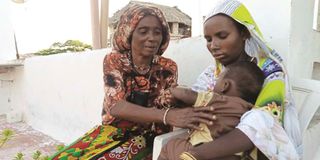Lamu grapples with chikungunya and dengue fever endemics

What you need to know:
- Most of the prevailing cases are found in Lamu Island areas of Kashmir, Kandahar, Gadeni, Bajuri, Wiyoni, Mkomani, Matondoni, Shella, Hidabo, Makafuni, and Mararani.
- In the mainland areas, such cases have been rampant in Hindi Division, Mokowe, Bar’goni, Mpeketoni and parts of Witu .
Fatma Mohamed, a 31-year-old mother of two, could have died of chikungunya disease were it not for her husband, Mr Mohamed Ali, who rushed her to Langoni Hospital in Lamu town.
Ms Mohamed was admitted to the facility for three days shortly after tests turned positive for the viral disease.
Chikungunya is among Kenya’s neglected tropical diseases. It is transmitted to humans by mosquitoes. It is caused by the chikungunya virus and its symptoms include fever, severe joint pain, muscle pain, swollen joints, headache, nausea, fatigue and rashes.
“I am happy that I have recovered. I thank my husband for rushing me to the facility. Else, I would have died,” said Ms Mohamed.
Mr Shee Kombo,50, a resident of Kiwayu Island in Lamu East, had to be urgently taken to the King Fahad Hospital in Lamu Town recently after he developed sudden fever, chills and severe headache with a sharp pain behind the eyes. She also felt muscle and joint pain plus extreme fatigue.
After various laboratory tests, he was diagnosed with dengue fever.
Dengue fever is another mosquito-borne viral infection found in tropical and sub-tropical climates worldwide. Patients suffering from the disease also show symptoms such as abdominal pain, nausea, vomiting and a faint red rash on the upper body.
The virus responsible for causing dengue can also cause an acute flu-like illness.
Elsewhere, Sindi Kale’s baby, two-year-old Sule, developed fever and frequent vomiting recently.
Ms Sindi lives in Kiangwe village in terror-prone Boni Forest. She sought assistance from local leaders to help her take her fourth-born baby to hospital as she does not have a source of income. The baby was later diagnosed with both chikungunya and dengue fever at Langoni Hospital.
Baby Sule was admitted at the facility for three days. “My baby is now okay. I was advised to ensure the baby takes enough water daily,” said Ms Sindi.
Ms Mohamed, Mr Kombo, and Baby Sule are just a few of the hundreds of cases of dengue fever and chikungunya that are being detected in Lamu almost daily.
Currently, Lamu is grappling with chikungunya and dengue fever, with some hospitals admitting being overwhelmed by the many admissions related to the two diseases in recent times.
At Langoni Hospital, the facility has a laboratory with advanced equipment that does all the tests required. The management confirmed that dengue fever and chikungunya are rampant. Statistics at the hospital show that more than 20 patients with severe chikungunya and dengue fever were admitted there in December alone, while more than 10 others who tested positive were treated at home.
Langoni Hospital Director and Consultant Surgeon, Dr Nurein Mohidin, said the facility is currently having many chikungunya and dengue fever patients’ admissions. This has forced them to discharge some patients prematurely to create space for others.
“All our wards are at full capacity,” said Dr Mohidin.
County Disease Surveillance Office admitted that dengue fever is rampant across Lamu, noting that at least 1,170 cases were confirmed between January and November 2021.
The number is high compared to 2020, where only 34 people were diagnosed with dengue fever.
The county’s health data also indicates that another 80 individualso suffered from Chikungunya in Lamu between January and February 2021. In 2020, no case of Chikungunya was reported in the county.
Most of the prevailing cases are found mostly in Lamu Island areas of Kashmir, Kandahar, Gadeni, Bajuri, Wiyoni, Mkomani, Matondoni, Shella, Hidabo, Makafuni, and Mararani. In the mainland areas, such cases have been rampant in Hindi Division, Mokowe, Bar’goni, Mpeketoni and parts of Witu .
Lamu Health Executive Anne Gathoni said in an effort to deal with the situation, routine surveillance has been ongoing across Lamu. She urged those with symptoms to present themselves to nearest health facilities so that their samples can be taken for further tests.
“We have a whole unit on disease surveillance here. These diseases, especially dengue fever, are managed conservatively. We have always encouraged patients to consume enough fluids and use Panadol for the fever. We’re no longer doing routine testing other than for surveillance,” said Dr Gathoni.
She also advised residents to maintain a clean environment and to get rid of any mosquito breeding grounds. “Stagnant water and bushes around homes will harbour mosquitoes and result in increased bites. When there is a number of infected individuals, the mosquitoes will pick the virus and take it to the next individual through a bite. My advice to the people is to eliminate all mosquito breeding sites near their homes and sleep under insecticide-treated bed nets.”
Mr Athman Abdalla, a resident of Mkomani, urged the devolved government to consider closing all the open sewers in the old town, terming them key mosquito breeding sites.
This report is produced in partnership with the African Investigative Journalism Conference, an initiative of the Journalism Department at the University of Witwatersrand in South Africa, and the Nation Media Group.





